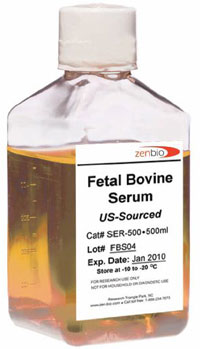The price of Fetal Bovine Serum (FBS) has drastically increased! At my university, we typically requested FBS from a large in-house supply purchased wholesale from an external source. One reason for this was to maintain consistency, as fetal bovine serum tends to vary from batch to batch. However, purchasing this way kept cost down – one half liter bottle of FBS could run around 500 dollars. Recently, the department sent out a notification that each lab would no longer be able to obtain a bottle of FBS, without it counting against its weekly budget. Going forward, 200 dollars will be deducted, reducing the overall funds available for the weekly purchase of other lab supplies.
Yesterday, I asked the Chairman’s secretary why this change had been made. She only knew that the price had gone up exponentially, but not why. So, I decided to do some investigatory work of my own. People often don’t understand that research is very expensive and time consuming work. An increase in the cost of supplies, means a decrease in how far the budget can be stretched, and an increase in the time it takes to get in essential supplies.
Fetal Bovine Serum (FBS)
 Fetal bovine serum is brown colored, semi-viscous liquid, used in the biotechnology and pharmaceutical industries for the making of vaccines and drugs, and commercially and academically for scientific research involving cell culture.
Fetal bovine serum is brown colored, semi-viscous liquid, used in the biotechnology and pharmaceutical industries for the making of vaccines and drugs, and commercially and academically for scientific research involving cell culture.
Fetal bovine serum, a by-product of the meat industry, is obtained specifically from fetal calf blood. The blood is collected aseptically (sterile), refrigerated, and allowed to coagulate. It is then centrifuged (spun rapidly); separating the serum from the clotted blood cells. The serum is then taken off and stored frozen. Rich in protein, growth factors, and other nutrients, it is used as a supplement in cell culture medium (normally at a 10% concentration) to support and encourage the growth of cells in vitro.
Supply and Demand
Direct cause of price increase
Fetal bovine serum is produced in the United States, Australia and New Zealand, South America ( mainly Brazil), and South Africa. Production is directly related to the amount of beef produced, and regulations effecting import and export. Economics, politics, and health concerns, are all reasons influencing the regulations influencing the supply of FBS globally. The import of FBS may or may not be allowed from certain origins into all countries. For instance, China does not permit the importation of FBS from the United States (U.S.). In terms of economics; the price of FBS originating from Australia and New Zealand had grown, such that it became cheaper for its traditional consumers to obtain FBS from the U.S. instead.
Demand for U.S. FBS has risen, as new markets have emerged globally, such as in South Korea. Not only is demand up, but supply is down. Droughts in recent years, as well as the consolidation of raw material suppliers and producers has constrained supplies in the U.S. Normal annual yield of FBS is 300,000 L, but in 2015 and 2016, the U.S. supply dwindled to just 200,000 L. The cost of FBS has seen a 300% increase in price over the past several years.
Indirect cause of price increase
Interestingly, a bill passed in 2005 by President Bush, calling for greater fuel efficiency caused a major shift in the availability and price of FBS. The “Ethanol Bill of 2005” caused the price of corn to double, as cattle are normally fed with corn, cattle ranchers could no longer afford to keep large herds. As, a result, they sold pregnant cattle for slaughter, making fetal calf blood for the production of FBS more available. The excess of FBS meant record low prices. However, in 2011 the bill expired, and the price of corn dropped, and herd rebuilding was once again possible. Therefore, pregnant animals were no longer sold for meat. With their calves kept on the farm, the supply of FBS dropped. In 2014 the price of U.S. FBS rose reportedly to $80 to $ 115 a liter.
I’m not sure where the FBS stocked at my university originates, but I suspect that because the batch that we currently have , and the price that is was obtained for, are no longer available; the University is penalizing its laboratories in an effort to be conservative, until the economic tides turn.
